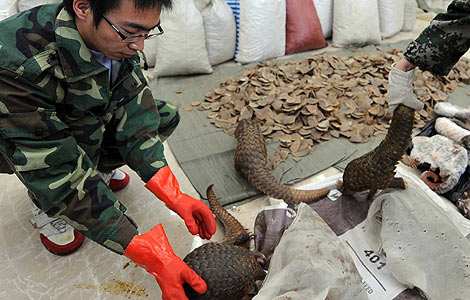China is fine with monitoring 'fine' particles
Updated: 2011-12-09 19:59
(Xinhua)
|
|||||||||||
BEIJING - China's Ministry of Environmental Protection this week announced that its proposal for tighter air-quality monitoring, which includes issuing standards for the much-talked-about "PM2.5" measure, has won overwhelming support in public feedback and that it would take citizens' advice in finalizing the measures.
In making the announcement, the ministry showed once again that China is responsive to public health concerns.
Particles less than 2.5 micrometers in diameter (PM2.5) are referred to as "fine" particles and are believed to pose health risks. Because of their small size (less than one-seventh of the average width of a human hair), these fine particles can lodge deeply into the lungs.
The fine particles have gradually come under the spotlight after media reports pointed out that China's air-quality monitoring has not been considering PM2.5 as a gauge of overall air quality. It is thought this is the reason for the frequent discrepancies between good ratings by government and the actual poor experience of urban Chinese.
Since then, experts from the ministry have admitted that the rapid growth of the Chinese economy has brought about more air pollution, but the current air standards, which remain unchanged for more than 10 years, are falling behind the changes.
Improving the air-quality index involves adding standards for ozone density and the revision of standards for other air pollutants, but adding PM2.5 standards is the most important amendment.
That's because improving the living standards of Chinese people means more cars and more power consumption, both of which contribute to the emission of PM2.5 as sources of fine particles include all types of combustion activities such as motor vehicles and power plants.
According to the draft, the new air-quality index is scheduled to be fully implemented nationwide in 2016, and the central government may designate certain regions to adopt it ahead of the national deadline.
In fact, implementing PM2.5 standards is no easy job.
Firstly, what PM2.5 standards fit China's economic conditions is still in discussion. Indeed, the PM2.5 standards are a relatively recent invention. The world's first such standards were issued by the United States in 1997.
Moreover, as a multi-source pollutant, PM2.5 is tricky to control technically. Research shows over half of PM2.5 emissions are not directly emitted, but are oxidations of other air pollutants.
Given these difficulties, China may be racing against time, but it is also comforting to recognize that it is making great strides to meet public health concerns.
Hot Topics
HIV/AIDS, Egypt protest, Thanksgiving, climate change, global economic recovery, home prices, high-speed railways, school bus safety, Libya situation, Weekly photos
Editor's Picks

|

|

|

|

|

|






